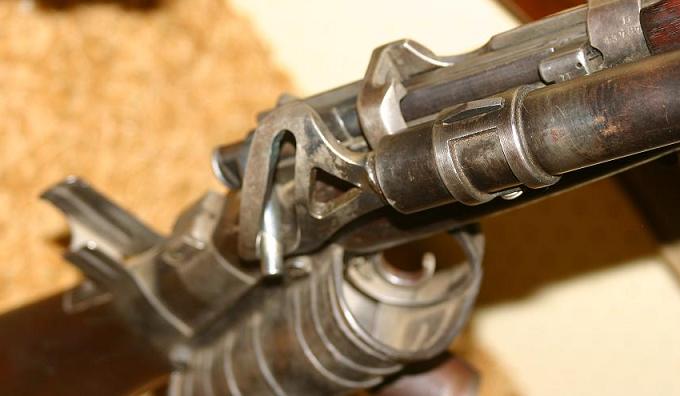So, let us pretend we are 1940s British ordnance officers, and we need more automatic rifles. What are we to do? There is so much war material that needs to be produced, and we have a limited amount of manufacturing capacity. But wait, we already have lots of Enfield rifles – they’re not automatic, but they are rifles! We can just slap on a gas piston to work the bolt…yep…automatically! Ok, and a pistol grip to make the gun reasonably handy. And a special extended magazine to make it more useful. And a shield doohickey to keep the shooter’s hand from getting roasted by gas from the piston. And a face guard to keep the shooter from inadvertently having their teeth knocked out by the bolt.
Okay, so the Howell Automatic Rifle wasn’t exactly the most successful British firearm ever developed. But it is an interesting glimpse into the desperation of the Royal military early in World War II. Similar concepts were also experimented with by the Australians (Charlton) and South Africans (Reider). Ultimately, all were supplanted by the Bren.

See all the photos (including several good detailed closeups of the magazine) at the Howell Automatic Rifle page in the Vault.

Greetings from Texas,
This is amazing! I’ve never even heard of this.
The British have made some truly ugly things over the years. And I am not even talking about the royal family.
http://en.wikipedia.org/wiki/Mars_Automatic_Pistol
GREAT writeup, and worthy of a Monty Python skit.
Satire must be very difficult in Great Britain; reality’ll beat you there every time.
Nice arcticle but with two imprecisions : the pistol grip is not for handiness, its angle makes the gun a pain to hold but allows the shooter to place his hand out of the bolt’s way, and the magazine isn’t special, it’s a regular Bren gun mag.
Anyway, these conversion Enfields weren’t bad weapons and equaled the Bren in accuracy and reliability, their main problem was ergonomics.
Found more info about these designs. Actually, only the Charlton had a cut stock forearm and an enlarged well to take both Bren and SMLE magazines, the Howell had an unchanged receiver and could only feed from the stock mags (normal 10 rounders or “trench” 20 rounders).
Also, the gas piston is free to slide completely out of its tube, so it doesn’t stop the bolt from being launched out of the gun and into the shooter’s eye, only the tiny sear is on the way, and it stays flush with the receiver for as long as the operator keeps the trigger pressed. So i assume that the “face guard” isn’t there only for protection, it probably doubles as the bolt recoil shield. What a gun.
3 years late, I know, but people may still read this article anyway so I thought I’d point out some mistakes:
The Howell was not developed during the 40’s, or even the 30’s for that matter. It was originally designed in 1918, during WWI. The Ordnance Board had nothing to do with the Howell and it was not made in response to a shortage of automatic rifles. Rather, the Ordnance Board actually thought the Howell unnecessary and rejected it outright. There is a persistent rumour that these rifles were issued to Home Guard units as anti-aircraft weapons when WWII came around, and while the Ordnance Board may have considered this, there is no evidence to suggest that any Howells were issued to anyone.
Basically, the Howell is not the WWII prototype that everyone seems to think it is, and it was actually quite an advanced design by WWI standards.
I don’t have much information on the Howell – can you recommend any good documented sources?